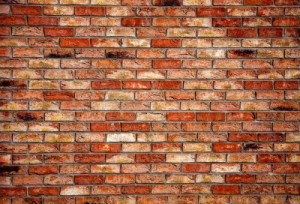Brick Walls
 Home buyers are drawn to certain exteriors. Many homeowners gravitate toward a brick home. It is resilient and durable and of course, pretty. If you are building, the choice can be complicated. There are many styles, grades, and colors. Choosing the correct grade is critical. Bricks are graded according to their outdoor use. Temperatures in the area will determine the grade of brick that works best. Some grades will withstand freezing temperatures but will not fare as well in a drier and milder climate. Some bricks are better suited for indoor use. Another type frequently used on exteriors is antique or used brick, reclaimed from old buildings that have been torn down and cleaned of mortar. This style does not have modern exterior ratings, but usually is presumed to be acceptable if it lasted outdoors for 50 or more years. Used brick usually has less sharp edges than new brick and a more textured surface.
Home buyers are drawn to certain exteriors. Many homeowners gravitate toward a brick home. It is resilient and durable and of course, pretty. If you are building, the choice can be complicated. There are many styles, grades, and colors. Choosing the correct grade is critical. Bricks are graded according to their outdoor use. Temperatures in the area will determine the grade of brick that works best. Some grades will withstand freezing temperatures but will not fare as well in a drier and milder climate. Some bricks are better suited for indoor use. Another type frequently used on exteriors is antique or used brick, reclaimed from old buildings that have been torn down and cleaned of mortar. This style does not have modern exterior ratings, but usually is presumed to be acceptable if it lasted outdoors for 50 or more years. Used brick usually has less sharp edges than new brick and a more textured surface.
Most homebuilding brick today is façade or facing brick. Common brick, as the name suggests, is the most common form, typically red brick. Brick colors can vary, however, from almost black to almost white, through a range of browns, reds and yellows. The color depends on the clay and other components used to make the brick. Colors also can be intermixed for more variety.
Standard exterior or face bricks have smooth surfaces, but there are many variations. Some bricks are finished on one side with what is called “struck” faces, inscribed with irregular lines. Others are “sand struck,” molded against sand to produce a rough texture. Another style is “glazed,” with a ceramic layer on one side.
Did you ever wonder why some bricks have holes? Most bricks are solid rectangles, but “structural” or building bricks are made with two or three holes in the wide face. This reduces the weight of a brick wall without any loss of structural support. The holes also create a larger mortar connection and can be used in some situations for reinforcing with steel bars. Exterior structural bricks are most commonly used on freestanding walls and not as facing on a house.
Standard or common bricks are nominally 2 by 4 by 8 inches, but specific dimensions will vary by manufacturer and the allowance for 3/8- or 1/2-inch mortar joints. Other sizes include king, which is thicker and longer; Roman, which is thinner and longer; and economy, which is square and longer. It’s best to look at samples and measure the actual sizes before making a selection.
All in all, brick choices can be difficult because of the many types, grades, and colors. Ludwig Mies van der Rohe once said, “Architecture starts when you carefully put two bricks together. There it begins.” Nothing could be truer.
Source: Tips on Choosing Exterior Brick.” www.HomeGuides.com Web. 18 June 2013.
Call us today to view our new home plans: 713-539-0048 – Sign up for our New Home Buying Tips
Visit our website: https://fairmontcustomhomes.com/
View Our Communities – View our available new home floor plans – View our photo gallery
Follow Us: Facebook – Twitter – YouTube – LinkedIn – Google Plus


Sorry, the comment form is closed at this time.